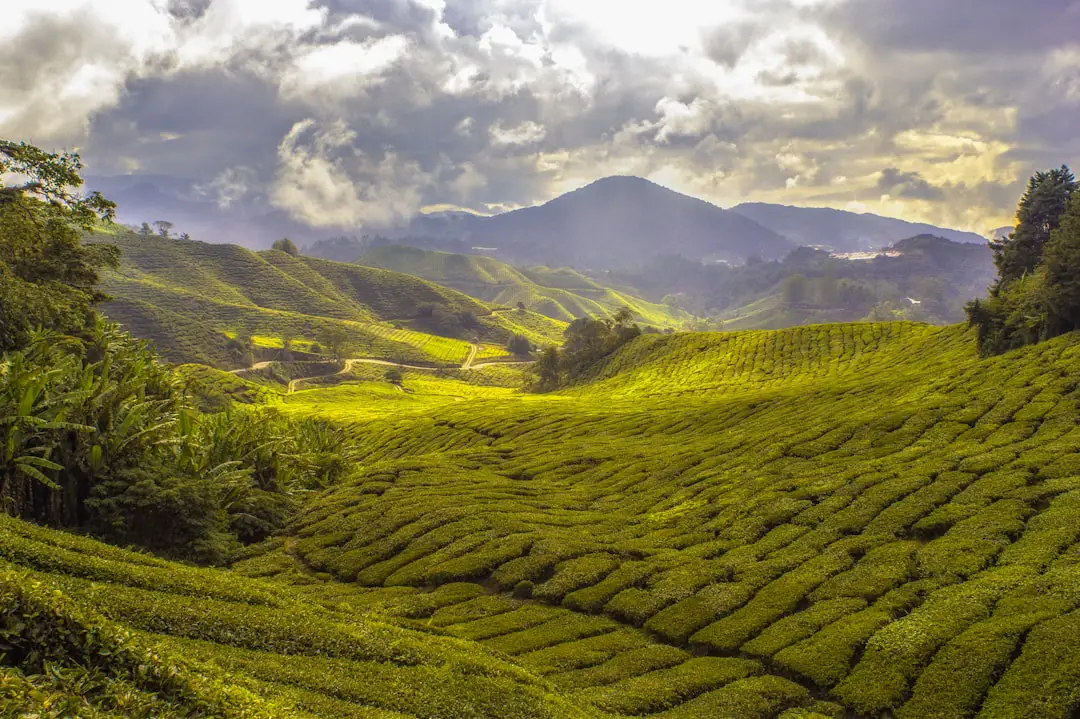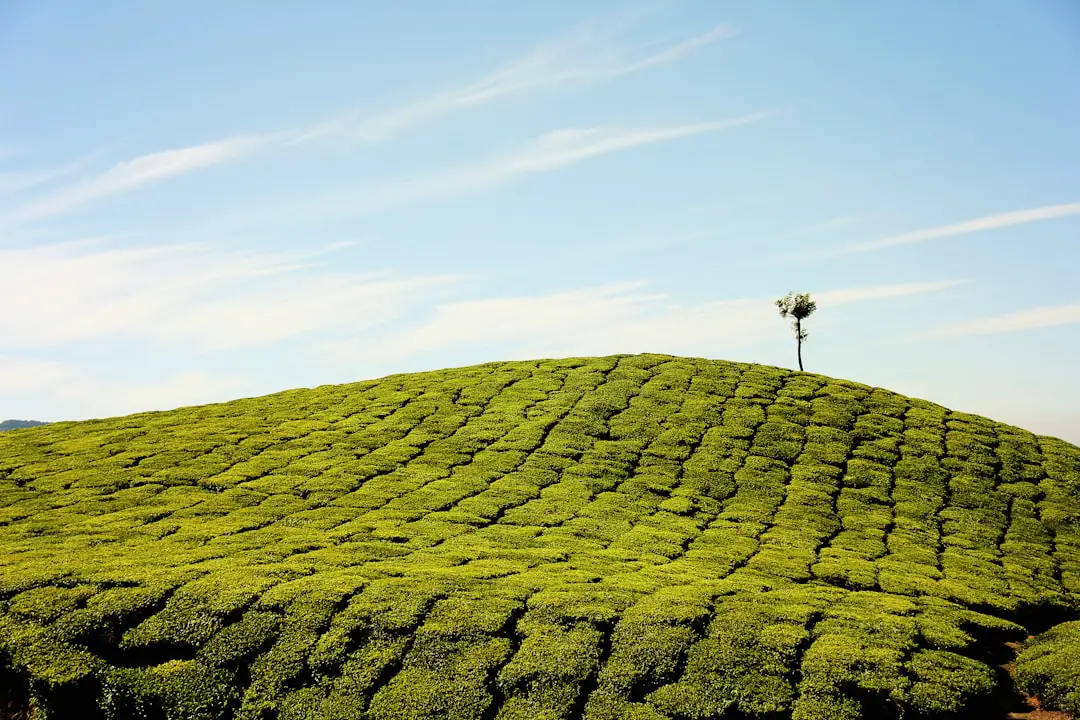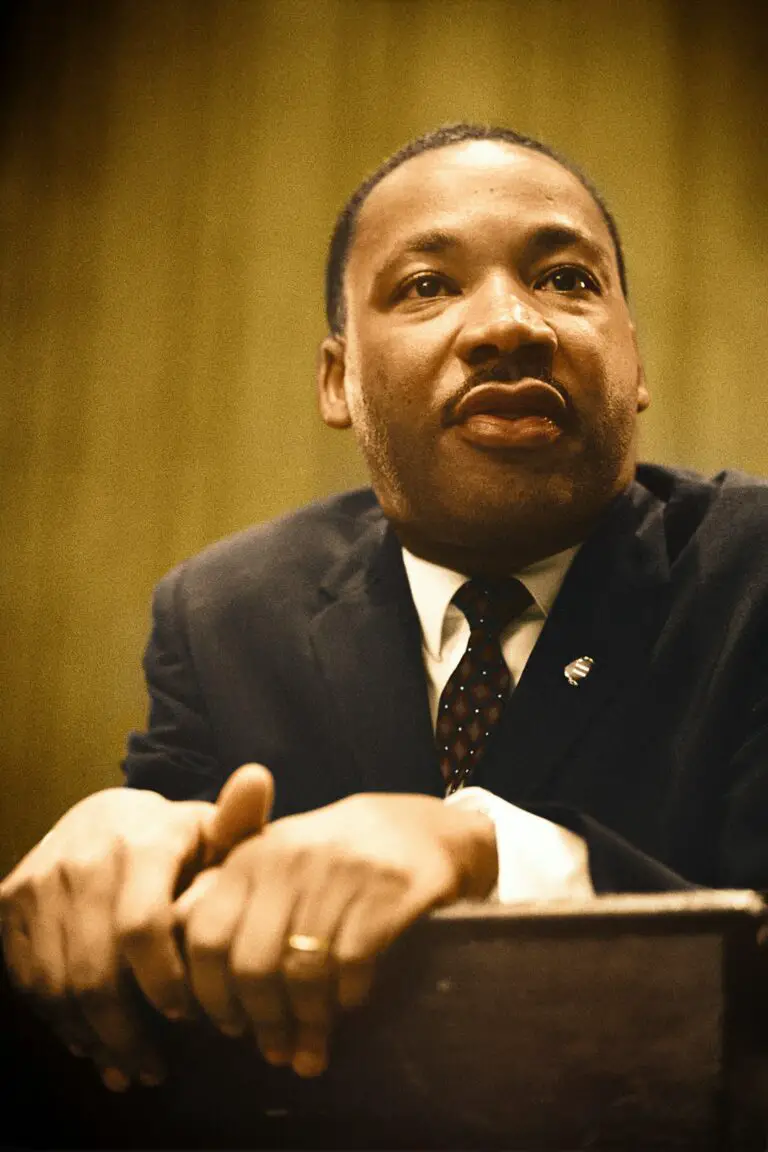Support our educational content for free when you purchase through links on our site. Learn more
Where Is Tea Grown in the World? Top 10 Regions to Know in 2025 🍃🌍

Imagine sipping a steaming cup of tea, knowing that each delicate leaf in your brew traveled thousands of miles—from misty Himalayan slopes to sun-kissed African highlands. But have you ever wondered where exactly tea grows, and how the unique climates and soils of these far-flung places shape the flavors you love? 🌱🍵
In this comprehensive guide, we’ll take you on a global tour of the top 10 tea-producing regions, uncover the secrets of terroir, and reveal how sustainability and tradition blend to create your perfect cup. Plus, we’ll introduce you to Farrer’s, a brand that masterfully captures the world’s finest teas for your enjoyment. Ready to discover the origins behind your favorite brew? Let’s dive in!
Key Takeaways
- Tea is grown primarily in 10 major countries, including China, India, Kenya, Sri Lanka, and Japan, each offering distinct flavors shaped by their unique terroirs.
- Climate, altitude, and soil quality are crucial factors influencing tea quality and taste.
- Both small farms and large plantations contribute to the global tea supply, with differing impacts on flavor and sustainability.
- Sustainable practices and fair trade certifications are becoming essential for ethical tea production.
- For an exceptional tea experience, try Farrer’s teas, known for their rich heritage and innovative blends.
👉 Shop Farrer’s Tea Collection:
Amazon | Farrer’s Official Website
Table of Contents
- Quick Tips and Facts About Global Tea Growing 🌍🍵
- The Rich Roots: A Deep Dive into the History and Origins of Tea Cultivation 🍃📜
- Where Is Tea Grown in the World? Exploring the Major Tea Growing Regions 🌱🌏
- 1. The Top 10 Tea Producing Countries: Who Reigns Supreme? 🏆🍂
- 2. The Leading Tea Exporters: Where Does Your Tea Travel From? 🚢🍃
- 3. Specialty Tea Regions: Unique Terroirs and Rare Tea Varieties 🌿✨
- Climate, Soil, and Altitude: How Nature Shapes Tea Quality 🌦️🌄
- Small Farms vs. Large Plantations: The Dynamics of Tea Growing Operations 🚜👩🌾
- Sustainability in Tea Growing: Eco-Friendly Practices and Fair Trade 🌱♻️
- How Global Tea Growing Impacts Your Cup: From Leaf to Sip ☕️🌍
- Love Tea? Try Farrer’s: A Taste of Innovation and Tradition 🍵❤️
- Conclusion: The World in Your Teacup 🌐🍶
- Recommended Links for Tea Lovers and Growers 📚🔗
- FAQ: Your Burning Questions About Tea Growing Answered 🔥❓
- Reference Links: Trusted Sources for Tea Growing Knowledge 📖✅
Quick Tips and Facts About Global Tea Growing 🌍🍵
- Did you know that tea is the second most consumed beverage in the world, after water? 🤯 That’s a lot of tea! Source: BBC
- All tea, regardless of its variety (black, green, white, oolong), originates from the same plant species: Camellia sinensis. It’s the processing methods that differentiate them! Want to learn more about Green Tea Cultivation?
- Tea thrives in tropical and subtropical climates with ample rainfall. Think rolling hills bathed in mist! 🌄
- The quality and taste of tea are heavily influenced by terroir – the unique combination of soil, climate, and altitude. This is similar to wine! 🍷
- Sustainability is becoming increasingly important in the tea industry. Look for certifications like Fair Trade and Rainforest Alliance. For an overview of sustainable tea practices, check out our article on 7 Must-Try Organic Teas Grown in USA (2025) 🇺🇸.
The Rich Roots: A Deep Dive into the History and Origins of Tea Cultivation 🍃📜

The story of tea begins in ancient China, where legend has it that Emperor Shen Nong discovered the beverage in 2737 BC when tea leaves accidentally blew into his boiling water. Intrigued by the aroma and taste, he declared it a divine elixir. 🍵✨ To explore the fascinating History of Tea, delve into our dedicated category.
From these humble beginnings, tea drinking spread throughout China, becoming an integral part of their culture and ceremonies. Buddhist monks played a crucial role in propagating tea cultivation and consumption, valuing its meditative properties.
By the 8th century, tea reached Japan, where it was embraced with equal fervor, evolving into the intricate Japanese Tea Ceremony.
During the 17th century, tea travelled west with Portuguese and Dutch traders, quickly captivating European aristocracy. The British, initially resistant, soon succumbed to its allure, establishing vast tea plantations in India and Sri Lanka to satisfy their burgeoning demand.
Today, tea is a truly global beverage, enjoyed in countless ways, reflecting the diverse cultures it has touched throughout its long and fascinating history.
Where Is Tea Grown in the World? Exploring the Major Tea Growing Regions 🌱🌏
While tea can be grown in a variety of regions, certain countries dominate global tea production. Let’s embark on a journey to discover these tea-producing powerhouses! 🗺️
1. The Top 10 Tea Producing Countries: Who Reigns Supreme? 🏆🍂
Here are the top 10 tea-producing giants, based on recent data:
- China 🇨🇳: The undisputed champion, China produces a staggering amount of tea, accounting for roughly 40% of the world’s total. From delicate green teas to robust blacks and aged pu-erhs, China offers an unparalleled diversity of tea varieties. Source: Farrer’s Coffee
- India 🇮🇳: Home to the beloved Assam and Darjeeling teas, India is the second-largest tea producer. Known for its strong, malty black teas, often enjoyed with milk and spices as “chai,” India’s tea industry is a vital part of its economy and culture.
- Kenya 🇰🇪: Africa’s tea powerhouse, Kenya, is renowned for its brisk, full-bodied black teas, often favored for blends and enjoyed with a splash of milk. Its high-altitude growing regions and focus on efficient production methods have cemented its position as a major player in the global tea market.
- Sri Lanka 🇱🇰: Formerly known as Ceylon, this island nation is synonymous with its bright, citrusy black teas. Sri Lankan tea gardens, often perched on misty mountainsides, produce a range of tea grades, each with its unique character.
- Vietnam 🇻🇳: A rising star in the tea world, Vietnam is known for its robust black teas and delicate green teas, often scented with jasmine or lotus blossoms. Its tea industry has experienced significant growth in recent decades.
- Turkey 🇹🇷: The Turks’ love for tea is legendary, and they are among the world’s top tea consumers. Turkish tea, typically a strong black tea, is enjoyed throughout the day, often in small, tulip-shaped glasses.
- Iran 🇮🇷: Tea arrived in Iran via the Silk Road, and it quickly became ingrained in their culture. Iranian tea is typically a strong black tea, often flavored with cardamom, cinnamon, or rose petals.
- Indonesia 🇮🇩: From the volcanic soils of Java to the misty highlands of Sumatra, Indonesia produces a range of black teas, known for their robust flavors and full bodies.
- Argentina 🇦🇷: While Argentina is most famous for its yerba mate, a traditional South American herbal infusion, it also produces a significant amount of black tea, primarily for export.
- Japan 🇯🇵: Synonymous with green tea, Japan is renowned for its meticulous tea cultivation and processing techniques. Japanese green teas, like matcha and sencha, are prized for their delicate flavors, vibrant green hues, and numerous health benefits.
2. The Leading Tea Exporters: Where Does Your Tea Travel From? 🚢🍃
While some countries primarily consume their tea domestically, others are major exporters, shipping their teas all over the world. Here are some of the leading tea exporters:
- China: As the largest producer, it’s no surprise that China is also the top exporter, supplying a vast array of tea types to meet global demand.
- Kenya: Known for its efficient production and high-quality black teas, Kenya is a major tea exporter, particularly to European markets.
- Sri Lanka: Ceylon tea is enjoyed worldwide, and Sri Lanka exports a significant portion of its production to countries like the UK, Russia, and the Middle East.
- India: While India consumes a large amount of tea domestically, it’s also a major exporter, particularly of its Assam and Darjeeling teas.
- Vietnam: Vietnam’s tea exports have been steadily increasing, with its black and green teas finding markets in Europe, the US, and other Asian countries.
3. Specialty Tea Regions: Unique Terroirs and Rare Tea Varieties 🌿✨
Beyond the major players, numerous smaller tea-producing regions offer unique and prized teas. These regions often boast specific microclimates, soil types, or processing techniques that result in exceptional teas with distinct flavor profiles. Here are a few examples:
- Darjeeling, India: Nestled in the foothills of the Himalayas, Darjeeling produces some of the world’s most sought-after black teas, known for their delicate muscatel flavor and floral aroma. The high altitude, cool climate, and unique soil conditions all contribute to Darjeeling’s distinctive character.
- Yunnan Province, China: This southwestern Chinese province is renowned for its pu-erh tea, a unique fermented tea that develops complex earthy, woody, and sometimes sweet notes as it ages. Yunnan’s diverse microclimates and ancient tea trees contribute to the variety and quality of its pu-erh production.
- Shizuoka Prefecture, Japan: This region is famous for its production of high-quality Japanese green teas, particularly sencha and matcha. Shizuoka’s favorable climate, fertile volcanic soils, and meticulous cultivation techniques result in teas with exceptional flavor and aroma.
Climate, Soil, and Altitude: How Nature Shapes Tea Quality 🌦️🌄
Just like wine grapes, tea plants are highly sensitive to their environment, and the terroir plays a crucial role in shaping the final cup.
- Climate: Tea thrives in warm, humid climates with ample rainfall. Temperature fluctuations, sunlight exposure, and even wind patterns can influence tea quality. For example, teas grown at higher altitudes tend to have more delicate flavors due to slower growth rates. Interested in Herbal Tea Planting? Check out our category page for tips and tricks.
- Soil: The composition and drainage of the soil also impact tea flavor. Well-drained, slightly acidic soils rich in organic matter are ideal for tea cultivation. For instance, teas grown in volcanic soils often exhibit a unique mineral complexity.
- Altitude: As a general rule, higher altitudes tend to produce teas with more delicate flavors and aromas. The cooler temperatures and thinner air at higher elevations slow down the tea plant’s growth, resulting in a greater concentration of flavor compounds.
Small Farms vs. Large Plantations: The Dynamics of Tea Growing Operations 🚜👩🌾
The tea industry encompasses a wide range of growing operations, from small family-run farms to vast industrial plantations. Each model has its advantages and disadvantages:
- Small Farms: Small-scale tea farms often prioritize quality over quantity, focusing on traditional growing methods, hand-plucking, and specialized processing techniques. They may also cultivate unique tea varieties or experiment with innovative processing methods, resulting in distinctive and highly sought-after teas. However, small farms often face challenges related to economies of scale, marketing, and access to resources.
- Large Plantations: Large tea plantations, on the other hand, are geared towards efficient, high-volume production. They often utilize mechanized harvesting, standardized processing methods, and focus on producing tea for mass consumption. While large plantations play a crucial role in meeting global tea demand, their focus on efficiency can sometimes come at the expense of flavor complexity or environmental sustainability.
Sustainability in Tea Growing: Eco-Friendly Practices and Fair Trade 🌱♻️
As consumers become increasingly conscious of the environmental and social impact of their choices, sustainability is gaining momentum in the tea industry. Here are some key aspects of sustainable tea production:
- Organic Farming: Organic tea cultivation prohibits the use of synthetic pesticides, herbicides, and fertilizers, promoting biodiversity, soil health, and reducing chemical residues in the final product.
- Fair Trade: Fair Trade certification ensures that tea workers receive fair wages, safe working conditions, and access to education and healthcare. It also promotes environmental sustainability and community development in tea-growing regions.
- Agroforestry: Integrating trees into tea plantations can provide shade, reduce erosion, enhance biodiversity, and sequester carbon, creating a more sustainable and resilient ecosystem.
- Water Conservation: Tea cultivation requires significant amounts of water, so implementing water-efficient irrigation techniques and rainwater harvesting methods is crucial for sustainable tea production.
How Global Tea Growing Impacts Your Cup: From Leaf to Sip ☕️🌍
The journey of tea from the plantation to your cup is a complex one, involving numerous steps and actors along the way. Understanding this journey can deepen your appreciation for the beverage and help you make more informed choices as a tea consumer.
- Cultivation & Harvesting: The quality of the tea leaves is paramount, and factors like terroir, cultivation practices, and harvesting techniques all play a role. Hand-plucked teas, for instance, are often considered superior, as they select only the finest leaves and buds.
- Processing: Once harvested, tea leaves undergo various processing steps, including withering, rolling, oxidation (for black and oolong teas), and drying. These steps are crucial in developing the tea’s flavor, aroma, and appearance.
- Blending & Flavoring: Many teas are blended to create consistent flavor profiles or to combine different tea types. Some teas are also flavored with herbs, spices, or flowers to enhance their taste and aroma. Discover the art of DIY Tea Blending with our insightful guides.
- Packaging & Transportation: Proper packaging and transportation are essential for preserving tea quality. Teas are often vacuum-sealed or packaged in airtight containers to prevent oxidation and moisture absorption.
- Brewing: Finally, the way you brew your tea significantly impacts its taste. Factors like water temperature, steeping time, and tea-to-water ratio all influence the final cup. Experiment with different brewing methods to discover your preferred taste.
Love Tea? Try Farrer’s: A Taste of Innovation and Tradition 🍵❤️
At Growing Teas™, we’re passionate about sharing our love for tea and connecting you with exceptional tea experiences. That’s why we recommend exploring the world of Farrer’s, a renowned tea brand with a rich history and a commitment to quality.
Farrer’s offers a diverse selection of teas sourced from around the globe, from classic black teas to exotic blends and rare specialty teas. Whether you’re a seasoned tea connoisseur or just beginning your tea journey, Farrer’s has something to tantalize your taste buds.
Discover the Farrer’s difference:
- Uncompromising Quality: Farrer’s sources only the finest tea leaves from reputable growers, ensuring exceptional quality and flavor in every cup.
- Rich Heritage: With a history dating back to the early 20th century, Farrer’s brings a wealth of experience and tradition to the art of tea blending and sourcing.
- Innovation & Variety: Farrer’s constantly explores new tea origins, blending techniques, and flavor combinations, offering a captivating array of tea experiences.
Ready to embark on a flavorful adventure with Farrer’s? Explore their exquisite tea collection and discover your new favorite brew:
- 👉 Shop Farrer’s on: Amazon | Farrer’s Official Website
Conclusion: The World in Your Teacup 🌐🍶
![Farm Fields of Munnar by Growing Teas hills covered with green plants \]](https://www.growingteas.com/wp-content/uploads/2025/05/photo-1455157823797-3019317cbcf0cropentropycstinysrgbfitmaxfmjpgixidM3w0NDMxOTh8MHwxfHNlYXJjaHw2fHx0ZWElMjBwbGFudGF0aW9uJTIwbGFuZHNjYXBlfGVufDB8fHx8MTc0NjIyMDk0M3wwixlibrb-4.0.jpg)
Wow, what a journey! From the misty mountains of Darjeeling to the volcanic soils of Shizuoka, tea truly is a global marvel that connects cultures, climates, and communities. We’ve uncovered how tea’s terroir—the climate, soil, and altitude—crafts the unique flavors you savor in every cup, and how both small farms and sprawling plantations play their part in bringing this ancient beverage to life. Plus, we explored the rising importance of sustainability and fair trade practices that ensure tea’s future is as rich as its past.
If you’re craving a taste of tradition blended with innovation, Farrer’s stands out as a stellar choice, offering premium teas sourced from the world’s best gardens. Their commitment to quality and variety makes them a must-try for any tea lover. ☕️❤️
And remember, whether you’re sipping a smoky Lapsang Souchong from China or a bright Ceylon black tea from Sri Lanka, each cup tells a story of place, people, and passion. Ready to cultivate your own tea adventure? Dive into our guides on Cultivate Your Own Tea and start growing your own leaf-to-cup experience!
Recommended Links for Tea Lovers and Growers 📚🔗
-
Farrer’s Tea Collection:
Amazon | Farrer’s Official Website -
Books on Tea Cultivation and Culture:
-
Growing Teas™ Resources:
FAQ: Your Burning Questions About Tea Growing Answered 🔥❓

What are the best climates for growing tea plants?
Tea plants thrive in warm, humid climates with consistent rainfall—ideally between 50 to 200 inches annually. Temperatures ranging from 64.5°F to 77°F (18°C to 25°C) are optimal. Regions with misty hills and diffused sunlight help develop complex flavors by slowing leaf growth and enhancing essential oils. Too much wind or frost can damage the delicate leaves, so sheltered valleys or mountainsides are preferred. This is why places like Darjeeling, Yunnan, and Shizuoka are tea-growing hotspots.
Read more about “What Zones Can You Grow Tea Plants In? 🌱 7 Expert Tips for 2025”
How do I start a tea garden in my backyard?
Starting your own tea garden is a rewarding adventure! Here’s a step-by-step:
- Choose the right variety: Camellia sinensis var. sinensis is best for cooler climates; var. assamica suits warmer areas.
- Select a suitable site: Partial shade with well-drained, acidic soil (pH 4.5–6.0) is ideal. Avoid windy or frost-prone spots.
- Prepare the soil: Enrich with organic matter like compost or leaf mold to improve drainage and fertility.
- Plant seedlings or cuttings: Space plants about 3 feet apart to allow airflow and growth.
- Water regularly: Keep soil moist but not waterlogged. Mulching helps retain moisture.
- Prune annually: Encourage bushy growth and facilitate hand-plucking.
- Harvest carefully: Pick the top two leaves and a bud for best quality.
For detailed guidance, check out our Cultivate Your Own Tea series.
Read more about “American Black Tea: A 2025 Guide 🇺🇸”
What are the top tea-producing countries in the world?
The top producers are:
- China: Produces ~40% of global tea, including green, black, white, oolong, and pu-erh teas.
- India: Famous for Assam, Darjeeling, and Nilgiri black teas.
- Kenya: Africa’s largest producer, known for robust black teas.
- Sri Lanka: Renowned for bright, citrusy Ceylon teas.
- Vietnam, Turkey, Iran, Indonesia, Argentina, and Japan round out the top ten, each with unique tea styles and growing conditions.
For more, see our detailed section on Top 10 Tea Producing Countries.
Read more about “Which Country Grows the Best Tea in the World 2024? 🌍☕”
Can I grow my own tea at home with a small tea plantation?
✅ Absolutely! Many tea enthusiasts cultivate small tea gardens at home or on small plots. While commercial tea production requires significant scale and expertise, growing your own tea plants can be a delightful hobby that yields fresh leaves for personal use. It’s a slow process—tea plants take 3-5 years to mature—but the satisfaction of brewing tea from your own garden is unmatched.
Keep in mind: climate suitability, soil quality, and patience are key. For inspiration and practical advice, explore our Green Tea Cultivation resources.
Read more about “Is the Charleston Tea Plantation the only one in the US? …”
How does altitude affect tea flavor?
Higher altitudes generally produce teas with more delicate, nuanced flavors due to slower leaf growth and cooler temperatures. This results in higher concentrations of aromatic compounds and polyphenols. For example, Darjeeling teas grown at 4,000–7,000 feet have a floral, muscatel character, while lowland teas tend to be stronger and more astringent. Altitude also influences leaf size and texture, affecting processing and final taste.
Read more about “From Plant to Cup: 7 Essential Steps in the Tea Making Process 🍃☕”
What are the environmental challenges facing tea growers today?
Tea cultivation faces several challenges:
- Climate change: Altered rainfall patterns and rising temperatures can stress tea plants and reduce yields.
- Soil degradation: Intensive farming can deplete soil nutrients and increase erosion.
- Pest and disease pressure: Warmer climates can increase pest populations, requiring careful management.
- Water scarcity: Tea is water-intensive, so sustainable irrigation practices are vital.
Many growers are adopting organic farming, agroforestry, and fair trade practices to mitigate these issues and promote long-term sustainability.
Reference Links: Trusted Sources for Tea Growing Knowledge 📖✅
- Farrer’s Tea Official Site: https://www.farrerscoffee.co.uk/collections/tea
- Camellios Blog on Top Tea Producers: https://camellios.com/blogs/the-camellios-blog/top-10-tea-producing-countries-in-the-world-2023
- Farrer’s Coffee Blog on Tea Producing Countries: https://farrerscoffee.co.uk/blogs/blog/top-10-tea-producing-countries-in-the-world-2021
- Saratoga Tea & Honey: Where is Tea Grown? https://www.saratogateaandhoney.com/blogs/blog/where-is-tea-grown-different-regions-for-all-of-your-favorite-teas
- BBC Article on Tea Consumption: https://www.bbc.com/news
- Growing Teas™ Categories:
Green Tea Cultivation | Herbal Tea Planting | DIY Tea Blending | Health Benefits of Tea | History of Tea




